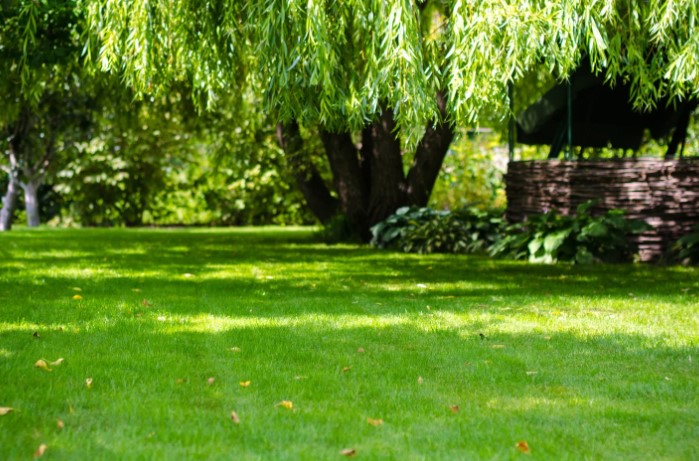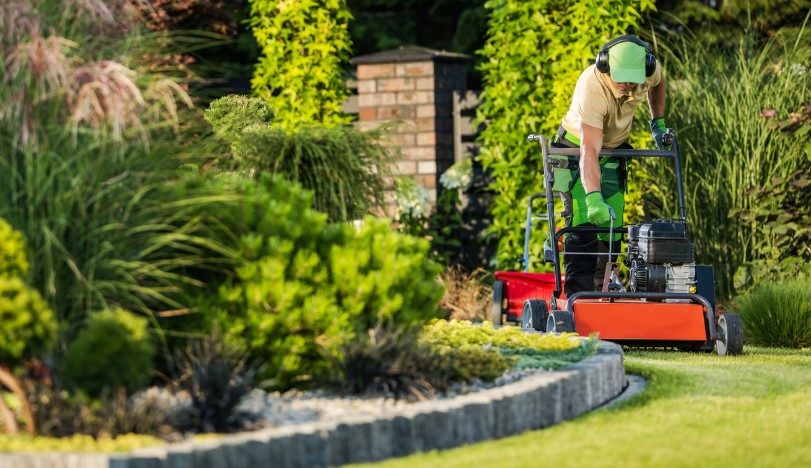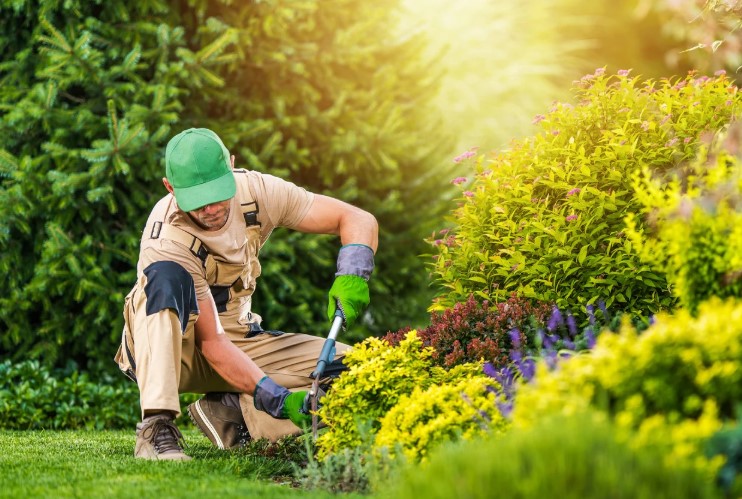- What is Lawn Scarification and Why is It Important?
- When is the Best Time to Scarify a Lawn in the UK? – When To Scarify Lawn?
- When is the Best Time to Scarify a Lawn in the UK?
- How Often Do I Need to Scarify My Lawn?
- No Grass Left After Scarifying – What to Do Next?
- Common Mistakes to Avoid When Scarifying a Lawn
- Top Tips and Advice for Lawn Scarification
- Conclusion – Choosing the Right Time to Scarify Lawn in the UK
Maintaining a lush, healthy lawn in the UK isn’t just about mowing and watering. One often-overlooked aspect of lawn care is scarification, and more importantly, understanding the right time to do it.
Over the years, I’ve learned that scarifying at the wrong time can do more harm than good, and the difference between a patchy lawn and a vibrant green carpet often comes down to timing.
This guide is all about helping you understand when to scarify lawn, whether you’re doing it for the first time or you’re looking to improve your annual lawn care routine.
What is Lawn Scarification and Why is It Important?
Lawn scarification is the process of removing thatch – a dense layer of dead grass, moss, and organic debris – from the lawn surface.
While a small amount of thatch can be beneficial by insulating the roots, too much can prevent water, air, and nutrients from reaching the soil.
When this happens, I notice my lawn starts to look dull, spongy, or prone to moss. That’s my sign that it’s time for scarification.
Removing this layer allows the grass to breathe, encourages stronger root growth, and gives your lawn a better chance to thrive.
What are Difference Between Scarification and Dethatching?
Scarification and dethatching are often confused, but they serve slightly different purposes:
| Process | Purpose | Depth of Treatment | Tools Used |
| Scarification | Removes surface-level thatch and moss | Light to moderate | Spring tine rake, electric/petrol scarifier |
| Dethatching | Removes deep thatch layers and compacted soil | Deeper | Heavy-duty dethatching rake, power dethatcher |
Scarification is a gentler method suitable for annual lawn maintenance, whereas dethatching is more intensive and needed less frequently.

When is the Best Time to Scarify a Lawn in the UK? – When To Scarify Lawn?
After years of working with my lawn and speaking with experts, I can confidently say that the best times to scarify in the UK are spring and autumn.
These seasons provide the ideal combination of temperature, moisture, and growth activity for grass to recover quickly after scarification.
When to Scarify Lawn in Spring?
Spring scarification is all about rejuvenation. I usually do this between late March and early May, but the exact timing depends on the weather. The grass should be actively growing, and the ground should be neither too wet nor too dry.
Spring is the time for light scarification. Since the lawn needs to recover and keep growing into summer, I avoid going too deep. This is especially helpful for removing surface-level moss and early thatch before it builds up too thick.
When to Scarify Lawn in Autumn?
Autumn is my preferred time for deeper scarification. I aim for September to early October, when the soil is still warm but not dry, and there’s typically plenty of rainfall to aid recovery.
This is when I go deeper and tackle any thick thatch or moss that built up over summer. The lawn has time to heal before winter sets in, and I often combine this with overseeding and fertilising to strengthen the grass before dormancy.
What Month Should I Scarify My Lawn?
Timing your scarification based on the calendar can be helpful, but it’s important to pair that with an assessment of your lawn’s condition. Here’s a month-by-month overview based on my experience in the UK:
| Month | Recommended? | Notes |
| January–February | No | Grass is dormant, risk of frost damage |
| March | Maybe (Late) | Only if weather is mild and grass is growing |
| April | Yes | Ideal time for spring scarification |
| May | Yes | Good final chance for spring session |
| June–August | No | Avoid – heat stress and dry soil |
| September | Yes | Best month for deep scarifying |
| October | Yes (Early) | Still suitable if mild and damp |
| November–December | No | Grass slows down, poor recovery |
I personally avoid any scarification between June and August and mid-November to February, as grass is either under stress or dormant.

When is the Best Time to Scarify a Lawn in the UK?
If I had to choose the best months overall, I’d say April and September. April gives the grass a fresh start after winter, while September lets me prepare the lawn for the colder months by getting rid of moss and built-up debris.
When Should I Scarify My Lawn for the First Time?
If your lawn is newly laid from turf or seed, don’t rush into scarifying. I always wait at least 12 months before attempting any scarification. The roots need time to establish, and aggressive raking can disturb young grass.
When I finally do scarify a new lawn, I start with a gentle pass using a spring tine rake instead of a mechanical scarifier. This helps the grass adjust and gives me a chance to see how it responds.
How Often Do I Need to Scarify My Lawn?
The frequency really depends on your lawn’s condition and how quickly moss and thatch build up. Here’s a general guide I follow:
| Lawn Condition | Frequency | Scarification Level |
| Well-maintained lawn | Once a year | Light |
| Thatch-prone lawn | Every 1–2 years | Moderate |
| Moss-heavy lawn | Twice a year | Moderate to deep |
If I notice my lawn feels spongy or drains poorly, I know it’s time for a session, even if I already scarified earlier in the year.

Scarifying Once vs Twice a Year – When Is It Necessary?
For most average UK lawns, once a year is enough, typically in autumn. However, if you have a lot of moss or live in a damp, shady area like I do, twice a year can make a huge difference.
In these cases, I do a light scarification in spring to clean things up, and a deeper one in autumn to really address the thatch and moss buildup. The key is to give the grass enough time to recover after each session.
No Grass Left After Scarifying – What to Do Next?
Sometimes, especially after a deep autumn scarification, your lawn might look like a battlefield, i mean no grass could be seen. Don’t panic—it’s happened to me, and the grass always comes back stronger with the right care.
To learn exactly what to do in this situation, check out my full guide: No Grass Left After Scarifying
Common Mistakes to Avoid When Scarifying a Lawn
Over the years, I’ve made a few missteps that slowed down my lawn’s recovery. Here are the most common mistakes I try to avoid:
- Scarifying when the ground is too wet or too dry
- Going too deep on the first try
- Not mowing before scarifying
- Skipping aftercare like overseeding and fertilising
- Doing it during extreme weather (frost or heatwaves)
Top Tips and Advice for Lawn Scarification
To make the most of your scarification, here’s what I always keep in mind:
- Check the weather: Choose a mild, dry day after rain.
- Mow first: Shorter grass makes scarifying easier.
- Start light: Especially if you’re new to it or doing it in spring.
- Follow up: Overseed bare patches and feed the lawn right after.
- Be patient: It can take a few weeks to see the full recovery.
Conclusion – Choosing the Right Time to Scarify Lawn in the UK
Timing is everything when it comes to lawn scarification. Scarifying at the wrong time can leave your lawn vulnerable, but done right, it leads to thicker, greener, and healthier grass.
Here’s a quick recap on when to scarify lawn:
- Spring (April–May): Light scarification to wake the lawn up
- Autumn (September–October): Deep scarification and moss removal
- Avoid summer and winter, as your grass won’t recover well
- Tailor the schedule to your lawn’s condition, not just the calendar
By planning scarification around your lawn’s actual needs and the UK’s seasonal changes along with our guide on when to scarify lawn, you’ll give it the best chance to thrive year after year.


0 Comments